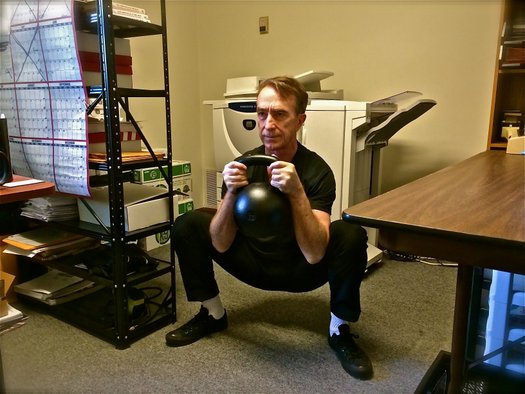Kettlebells at Work: Reversing the Negative Health Effects of Extensive Sitting at the Workplace
By Dr. Patrick Roth, M.D.
Swing Time—Mean Style
Considerable attention has been focused on the role of the workplace in back pain. Too much sitting—as described by Czech neurologist Vladimir Janda—can result in "lower cross syndrome" which is marked by weak gluteal muscles and tight iliopsoas muscles. Since the gluteal muscles are located posteriorly and the psoas muscles are located in the front of the body, the weakening of one and tightening of the other naturally creates an imbalance. This imbalance can put too much stress on the back, resulting in back pain.
Attempts to address this issue have mostly revolved around redesigning the workplace. These attempts have included an assortment of ergonomic interventions—taking breaks from sitting, changing computer screen positions, specially designed chairs, etc. Unfortunately, these ergonomic interventions have largely turned out to be ineffective for alleviating back pain.
We are advised to get up, stretch, and walk around to counter the excess sitting while at work. While this is sound advice, my years as a neurosurgeon—and back pain sufferer—have shown me there is a better alternative. Keeping a
kettlebell under your desk and performing kettlebell swings for one minute each hour may alleviate your back pain and trim your waistline.
One small kettlebell hidden under a desk in the office can provide time-effective back and hamstring strengthening, along with hip-flexor stretching. In addition, it is a cardiovascularly-stimulating, calorie-burning exercise. One minute of swings will burn 20 calories. If done each hour, this minute of swings will counter balance the 20 calories per hour not burned while sitting (as compared to a non-sedentary job).

John Goblet Squats the 66 pounder
Perhaps the most important benefit of having a kettlebell in the workplace is the potential for mood elevation. Interestingly, the most effective "ergonomic" intervention for back pain turns out to be improved job satisfaction. I am convinced that a culture of intense, intermittent bouts of exercise at the workplace would increase productivity, improve moods, and improve job satisfaction. It may turn out to be the ultimate ergonomic intervention. A kettlebell is certainly a better investment than an expensive, ergonomically-designed chair.
The prevalence of back pain is staggering. At any given time, 20% of us are experiencing back pain. Over the past year, the prevalence has risen to 40%. In a lifetime, that number approaches 80%!
Dragon Door CEO John Du Cane cleans the new 66 lbs kettlebell
Excessive sitting has also been implicated in a number of other health problems including impaired glucose metabolism and metabolic syndrome (which includes increased blood pressure, increased cholesterol levels, and excess body fat around the waist, all of which can contribute to a shortened lifespan).
Incorporating kettlebell swings into your workday is a fast, efficient and inexpensive way to mitigate the adverse health effects of your desk job.
So, grab a kettlebell—and maybe even a coworker—and swing your way to better health.
 Dr. Patrick Roth is a neurosurgeon practicing in New Jersey. He is the Chairman of the Department of Neurosurgery at Hackensack University Medical Center and the Director of the Hackensack Neurosurgical Residency Program. He has authored numerous publications related to the spine. He has been a perennial recipient of Castle and Connolly "Top Doctors" as well as New York Magazine’s "Best Doctors" and New Jersey Magazine’s "Top Doctors" His interests include medical decision-making, minimally invasive spinal surgery, and rehabilitation of back pain. He has had a life-long interest in exercise and diet. He lives in northern New Jersey with his wife and two children.
Dr. Patrick Roth is a neurosurgeon practicing in New Jersey. He is the Chairman of the Department of Neurosurgery at Hackensack University Medical Center and the Director of the Hackensack Neurosurgical Residency Program. He has authored numerous publications related to the spine. He has been a perennial recipient of Castle and Connolly "Top Doctors" as well as New York Magazine’s "Best Doctors" and New Jersey Magazine’s "Top Doctors" His interests include medical decision-making, minimally invasive spinal surgery, and rehabilitation of back pain. He has had a life-long interest in exercise and diet. He lives in northern New Jersey with his wife and two children.
Back